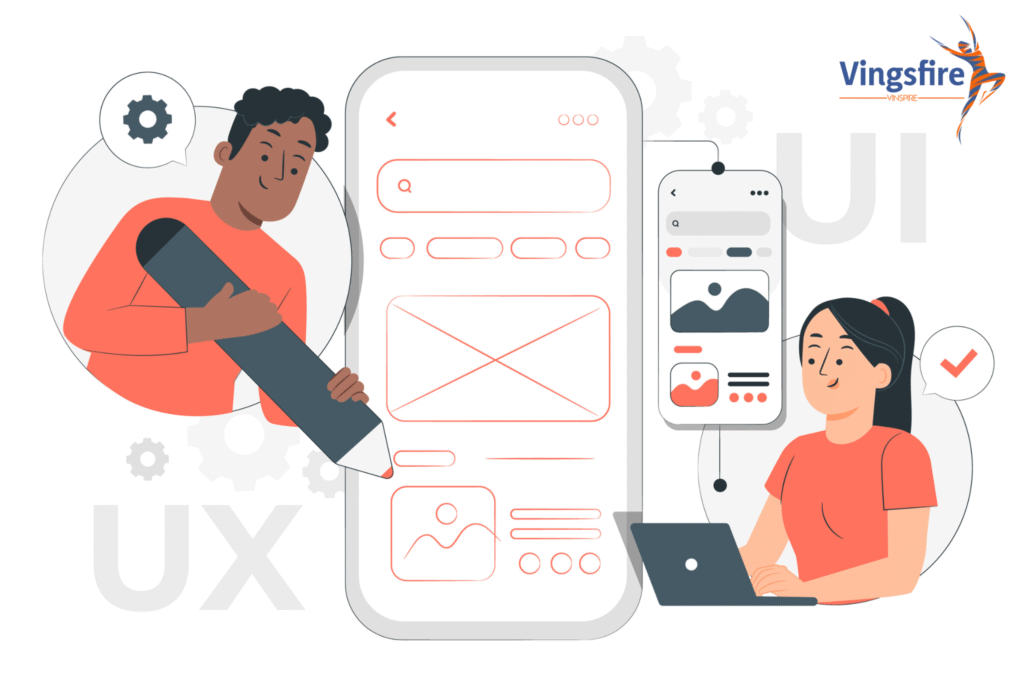
In today’s digital-first economy, user experience design has become the defining factor between successful products and forgotten ones. With 88% of consumers less likely to return to a website after a poor experience, investing in UX Design isn’t just good practice—it’s business-critical. At Vingsfire, we’ve transformed countless digital products through human-centered user experience design that drives engagement, loyalty, and revenue.
This comprehensive guide will explore:
- The fundamental principles of modern UX Design
- 7 psychological triggers that create addictive experiences
- The complete UX Design process from research to launch
- Industry-specific applications and success stories
- Common UX Design pitfalls that hurt conversions
- Emerging trends shaping the future of UX
- How to choose the right UX Design partner
What is User Experience Design? (The 2025 Perspective)
UX Design is the science and art of creating products that provide meaningful, relevant experiences to users. It encompasses:
✔ User Research – Understanding behaviors, needs, and motivations through methods like interviews and surveys
✔ Information Architecture – Organizing content for findability and usability
✔ Interaction Design – Crafting intuitive interfaces and workflows
✔ Usability Testing – Validating designs with real users
✔ Accessibility – Ensuring inclusive experiences for all abilities
Modern UX Design focuses on creating products that are:
- Useful
- Usable
- Desirable
- Findable
- Accessible
- Credible
- Valuable
UX Design vs. UI Design
| Aspect | User Experience Design | User Interface Design |
|---|---|---|
| Focus | Entire user journey | Visual/interactive elements |
| Methods | User testing, analytics | Visual design, prototyping |
| Output | User flows, wireframes | High-fidelity mockups |
| Success Metrics | Task completion, satisfaction | Visual consistency |
7 Psychological Principles for Exceptional User Experience Design
1. Hick’s Law
Simplify choices to reduce decision paralysis (ideal: 5-7 options max)
2. Fitts’s Law
Optimize target size and distance for effortless interaction
3. Jakob’s Law
Leverage familiar mental models users already know
4. The Von Restorff Effect
Make important elements visually distinct
5. The Zeigarnik Effect
Use progress indicators for multi-step processes
6. Miller’s Law
Chunk information into groups of 5-9 items
7. The Aesthetic-Usability Effect
Beautiful designs are perceived as more functional
The User Experience Design Process: Step-by-Step
1. Discovery & Research
- Conduct user interviews (5-7 participants)
- Create detailed personas (3-5 primary archetypes)
- Analyze competitor experiences (SWOT analysis)
2. Information Architecture
- Develop sitemaps (card sorting exercises)
- Create user flows (happy paths + edge cases)
- Establish navigation patterns (tested via tree testing)
3. Wireframing & Prototyping
- Build low-fidelity prototypes (paper or digital)
- Conduct concept testing (5-10 users)
- Iterate based on feedback (3-5 cycles typical)
4. Usability Testing
- Recruit representative users (5-10 per round)
- Conduct moderated/unmoderated tests
- Analyze success rates and pain points
5. Implementation & Launch
- Collaborate with developers (agile sprints)
- Conduct QA testing (accessibility audits)
- Monitor analytics post-launch
6. Continuous Improvement
- Gather user feedback (NPS, CSAT surveys)
- Analyze behavioral data (heatmaps, session recordings)
- Plan iterative enhancements
Industry-Specific User Experience Design Applications
E-Commerce
- Streamlined checkout flows (reduce cart abandonment)
- Personalized recommendations (increase AOV by 30%)
- Mobile-first design (60% of traffic is mobile)
FinTech
- Simplified onboarding (reduce drop-offs by 50%)
- Secure transaction flows (build trust)
- Complex data visualization (make insights actionable)
Healthcare
- Accessible patient portals (WCAG 2.1 compliance)
- Clear medical information (health literacy principles)
- Telemedicine experiences (reduce no-shows)
SaaS
- Intuitive dashboards (reduce training time)
- Empty state design (guide new users)
- Feature discoverability (increase adoption)
5 Costly User Experience Design Mistakes
⚠ Designing Without Research (58% of UX fails stem from poor research)
⚠ Overcomplicating Navigation (Users should find key features in 3 clicks max)
⚠ Ignoring Mobile Users (Mobile accounts for 60% of web traffic)
⚠ Neglecting Accessibility (Excludes 15% of potential users)
⚠ Skipping Usability Testing (50% of UX issues are caught in first test)
Emerging User Experience Design Trends for 2025
🔮 AI-Powered Personalization – Adaptive interfaces that learn user preferences
🔮 Voice Interfaces – Beyond screens to conversational UX
🔮 Emotional Design – Creating deeper psychological connections
🔮 Micro-Interactions – Delightful animations that guide users
🔮 Inclusive Design – Experiences accessible to all abilities and contexts
Why Choose Vingsfire for User Experience Design?
Our user experience design services deliver:
- Data-Driven Approach – Decisions grounded in research, not assumptions
- Conversion Optimization – Experiences that drive business KPIs
- Cross-Platform Expertise – Consistent journeys across all touchpoints
- Future-Ready Solutions – Implementing tomorrow’s UX trends today
Conclusion: The ROI of Great User Experience Design
Exceptional user experience design delivers measurable business impact:
- Increases conversion rates by up to 400%
- Reduces support costs by 50%
- Improves customer retention by 300%
- Enhances brand perception by 70%
Ready to transform your digital experience? Vingsfire offers free ux design consultations to elevate your product.
